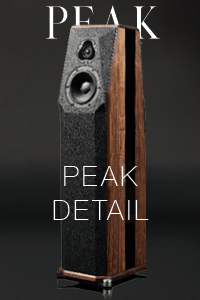 Power output meters are just cool. Back in the late 80s when the legendary Audio Research D-79 amplifier stood as my system’s cornerstone, watching the meters bounce into the red “caution” area—as the SPL got somewhat out of hand—made me feel like a mad scientist in a Mothra movie, waiting for sparks to fly. Fortunately, they never did, and my D-79 never missed a beat.
Power output meters are just cool. Back in the late 80s when the legendary Audio Research D-79 amplifier stood as my system’s cornerstone, watching the meters bounce into the red “caution” area—as the SPL got somewhat out of hand—made me feel like a mad scientist in a Mothra movie, waiting for sparks to fly. Fortunately, they never did, and my D-79 never missed a beat.
Today, my hair is as gray as the front panel on my ARC REF 150 power amplifier, which has served me equally well. But with a pair of speakers possessing an 88dB sensitivity rating, there are times when I find myself itching for a bit more power. And as awesome as a pair of REF 750s sound, the idea of replacing 36 KT120 power tubes on a semi-regular basis scares me. Perhaps if I could buy them by the palette at Costco…
For every one that’s lusted after a Ferrari and bought a Porsche 911 because it just made more sense on a daily basis, I submit the ARC REF 250 monoblocks. At $26,500 per pair, they are not an impulse purchase. Yet for those with an ARC amplifier (or amplifiers) already in their system, trading up isn’t a stretch. ARC’s Dave Gordon likes to say that the company’s best entry-level product “is a good, clean piece of used ARC gear.” Sounds like it’s time to pass that pair of REF 110s or VT100 on to another happy owner, and roll up to the bar for a pair of REF 250s. Then again, I can justify anything related to audio.
Quite the Trip
I have one main requirement for five-figure hi-fi: It has to take you on a trip, giving you an immersive experience that allows you to forget about the system and groove on the music. Forget about specs, measurements, tube, or transistor. Once the REF 250s have about 45 minutes on the clock, they take you there.
What better place to start than with the Beatles’ Magical Mystery Tour in stereo? Argue mono versus stereo all day long, but the latter version is extremely trippy, and as wide as a stretch of US 40, driving through Kansas on a clear, sunny day. Lennon is all the way out in Missouri, McCartney is over in Colorado, Ringo drums g somewhere in Nebraska, and George Harrison sits in the seat right next to you. Who needs drugs when music sounds this good? The mix tightens up on Revolver, with more dynamics. Harrison’s guitar blazes out in front of the speakers, buzzing in my head during the chorus on “Taxman.”
Next up, AC/DC. Taking advantage of an all-ARC amplification chain, this time using the REF Phono 2, AVID Acutus Reference SP, and Lyra Atlas cartridge (mounted on the TriPlanar arm), the 45RPM single of “Let’s Get it Up” (from For Those About to Rock) sends the power meters dancing at the edge of the caution zone. It’s like old times, but better. Much, much, better. Move over Rover, the new REF series is where it’s at. Not stopping there, I dial up the 24/96 release of Kiss’ Destroyer from HD Tracks. Aural madness ensues.
The sheer dynamic punch the REF 250s possess is simply unbelievable—the soundstage never collapses, even at near concert-hall levels. I haven’t listened to music this loud in my listening room in a long time. Yet the REF 250s handle it so effortlessly, it’s easy to keep goosing the volume control further and further, waiting for a hint of compression or distortion. It never arrives. With all due respect to the ARC dealer network, unless a bunch of listeners have fearfully inefficient loudspeakers, I don’t know why they’d need the REF 750s.
Moving the cables back to the REF 150, the amplifiers sound relatively similar, especially at modest levels. Still, the full mono chassis and bigger power supplies make for a wider, deeper soundstage and more solid foundation to the bass lines, no matter what kind of music pours out of the speakers. Yes, the REF 250s are double the cost, but offer a commensurate increase in performance.
A quick beverage break reveals I’m listening way too loud. My ears now have a slight tingle, so the volume comes down from 81 on the REF 5SE to a more prudent 30. Coasting through Aimee Mann’s new Charmer album provides an audio sorbet that calms and cleanses the palette before I peruse recent Music Matters Blue Note reissues. The REF 250s’ extra power and separate power supplies expand Blue Note’s super stereo feel beyond the norm, excelling in texture retrieval.
Forget The Sheffield Drum Record. Art Blakey’s Free For All is an amazing example of the maximum amount of drum sound a vinyl groove can hold. The REF 250s take the music beyond conceivable limits. I continue to push the volume, but my system never runs out of juice. This is the closest I’ve come to actually hearing a real drum kit in my room. Cymbal tone and texture are spot on, but Blakey’s explosive drumming doesn’t flatten out for lack of amplifier reserve.
Even with a fairly compressed track like U2s “Beautiful Day,” soundstage depth impresses. The Edge’s backing vocals, often lost in the mix, occupy their own private space, well off to the left speaker boundary, yet unmistakable nonetheless. Given how well they reproduce average recordings, the REF 250s seem borderline miraculous.
Slowing the groove for Mickey Hart’s audiophile classic Dafos makes for a welcome reunion. The delicate percussion in “The Subterranean Caves of Kronos” gets rendered with sublime smoothness, putting me at rest for almost three minutes until the monstrous drums of “The Gates of Dafos” sledgehammer my body into the listening chair and place me in the middle of a tribal mating ritual. Once again, the REF 250s strike an ideal balance between control, finesse, and impact. Herein lies the magic: massive power, yet the REF gear starts and stops on a dime, allowing for an incredibly fatigue-free experience.
Easy Implementation
The REF 250s prove at ease with every speaker we have at our disposal: GamuT S9, Sonus Faber Ellipsa SE, B&W 802D (notoriously difficult to drive), and even the Magnepan 1.7. Thanks to multiple taps at 16, 8, and 4 ohms, you should be able to find the winning combination for your speakers.
Setup is also a snap, and at 73 pounds each, the REF 250s are not too dificult to move. As with any tube amplifier, they require adequate ventilation. The REF 250s are fan-cooled and extremely silent in operation. They use the same 20-amp IEC connector as other ARC gear, so keep this in mind if you are thinking of upgrading power cords. ARC claims power usage as 700 watts at 250-watt output, and 1000 watts “maximum.” While you can use both on a 15-amp circuit, listeners pumping up the volume at high levels will benefit from a 20-amp dedicated circuit for the amplifiers.
Along with doubling the power supply from the REF 210 it replaces, the REF 250 utilizes a design very similar to the REF 150, with eight KT120 power tubes per channel (instead of four) being driven by another pair of KT120s and the 6H30 that seems to be universal in current ARC amplifiers. A 6550C is employed as a voltage regulator. In a nod to past ARC designs, a traditional analog meter replaces the fluorescent display.
The KT120 tube proves excellent across the range. In addition to the increased power dissipation (which translates into increased power output), the KT120-based ARC amplifiers have more aural ease than earlier amplifiers using the 6550. Depth and air are more abundant, with speakers disappearing in the room more convincingly. And nobody’s going to complain about that.
Audio Research REF 250 Monoblocks
MSRP: $26,500/pair
Peripherals
| Analog Source | AVID Acutus Reference SP TriPlanar Lyra Atlas |
| Digital Source | dCS Paganini stack Sooloos Control 15 Aurender S10 |
| Preamplifier | ARC REF 5SE |
| Phonostage | ARC REF Phono 2SE |
| Speakers | GamuT S9 Magico S5 Sonus faber Ellipsa SE B&W 802D |
| Power | RSA Maxim and Dmitri |
| Cable | Cardas Clear |
| Accessories | Furutech DeMag and DeStat Audio Desk System RCM GIK acoustic panels and Tri Traps |
















